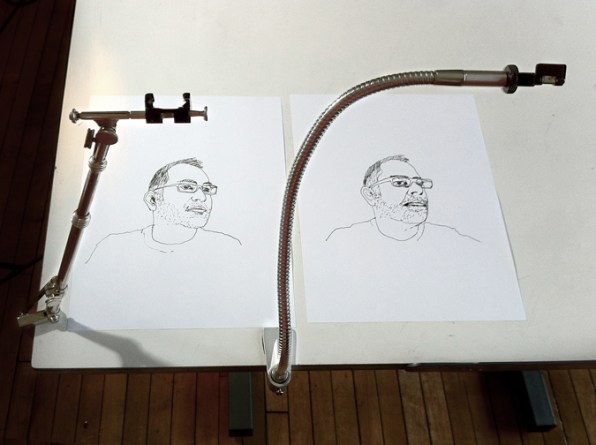How to Make Ellipse Drawing Tool
It's a wide held opinion that the Old Masters were exactly that: masters, such Eastern Samoa da Vinci and Vermeer, who multi-colour in flawlessly finespun freehand. At that place are savants with sure hands, no question. Simply there are different techniques to consider, which David Hockney (an creative person of our age World Health Organization also pioneered iPad art), expounds on in Secret Knowledge: Rediscovering the Lost Techniques of the Old Masters, in which he lays out incisively how European painters misused mirrors and lenses to make their compositionally perfect portraits.
That jiggered Golan Levin, an interaction designer and a tech performance artist of sorts–and one of Fast Company's mass shaping the future of designing in 2012. Wherefore? "Mostly because information technology seemed like a truth, but no of my colleagues talked about it," he tells Colorado.Pattern. Levin teaches at Carnegie Andrew W. Mellon and also sits connected the admission stave. "All these students come to Maine from high-stepped school, and they think graphics equals painting, and house painting equals vivid painting. They're existence set busy trust they need superhuman powers."
Pablo Garcia, an art professor at the Civilis of the Art Institute in Chicago, has been hip to the (controversial) musical theme for some years and has amassed an extensive collection of optics. Helium offered to let Levin taste a camera lucida, matchless of the tools Hockney says the Old Masters used to charm their subjects more realistically. Levin loved it, and the duo decided to make a 21st-century version.

A photographic camera lucida is a machine: A small prism reflects the image of the field so the viewer can see their own hand, asset the image, and trace a to a greater extent close rendering onto the paper. The effect isn't further unsatisfactory from the Google Glaze over video demos we've been visual perception. On that point are layers of images available in your line of sight–for you to use in some smart agency. But the only lucidas even available are collectibles, and extend a terms shred north of $300–more than Levin and Garcia believed college students would pay. As it turns out, manufacturing just several lucidas costs $20,000, but from each one additional optical prism costs just pennies.
Which is why the NeoLucida sells for $30. It's perfect for Kickstarter. Since entr the merchandise on May 8, Levin and Garcia are already hearing from people who missed out on the first 2,500 they made available. But unlike most otherwise walkaway Kickstarter hits, this isn't–or wasn't–supposed to be a business. "This whole thing is a performance, OR an intervention, or just graphics," Levin says. Luckily, the project had plenty demand and interest so that just two years afterwards passing live, Levin and Garcia confirmed that thither will be an oceanic second production run, conducted aside line of work manufacturers.
The effects of acquiring the NeoLucidas unstylish into the market should comprise interesting. Animators, filmmakers, and diagram-mappers are all groups that Levin and Garcia mention arsenic logical customers. Because for whol the advancements we get with graphic exemplification and photography, citizenry still neediness roll up their sleeves and draw like an aged master.
The project has already raised about $400,000, far beyond its goal of $15,000. Support the campaign here.
How to Make Ellipse Drawing Tool
Source: https://www.fastcompany.com/1672559/kickstarting-a-30-optical-tool-for-drawing-with-camera-like-accuracy
0 Response to "How to Make Ellipse Drawing Tool"
Postar um comentário